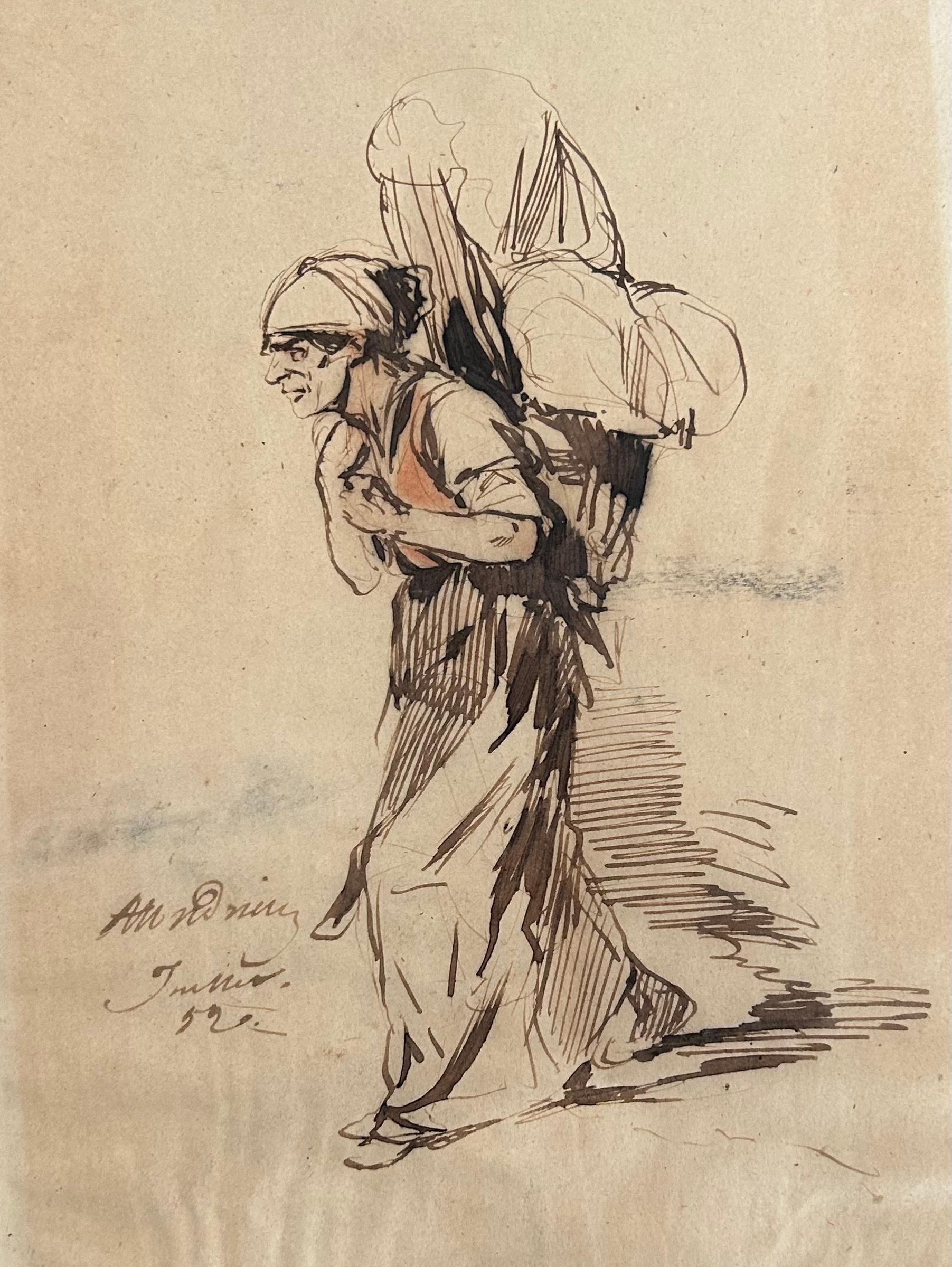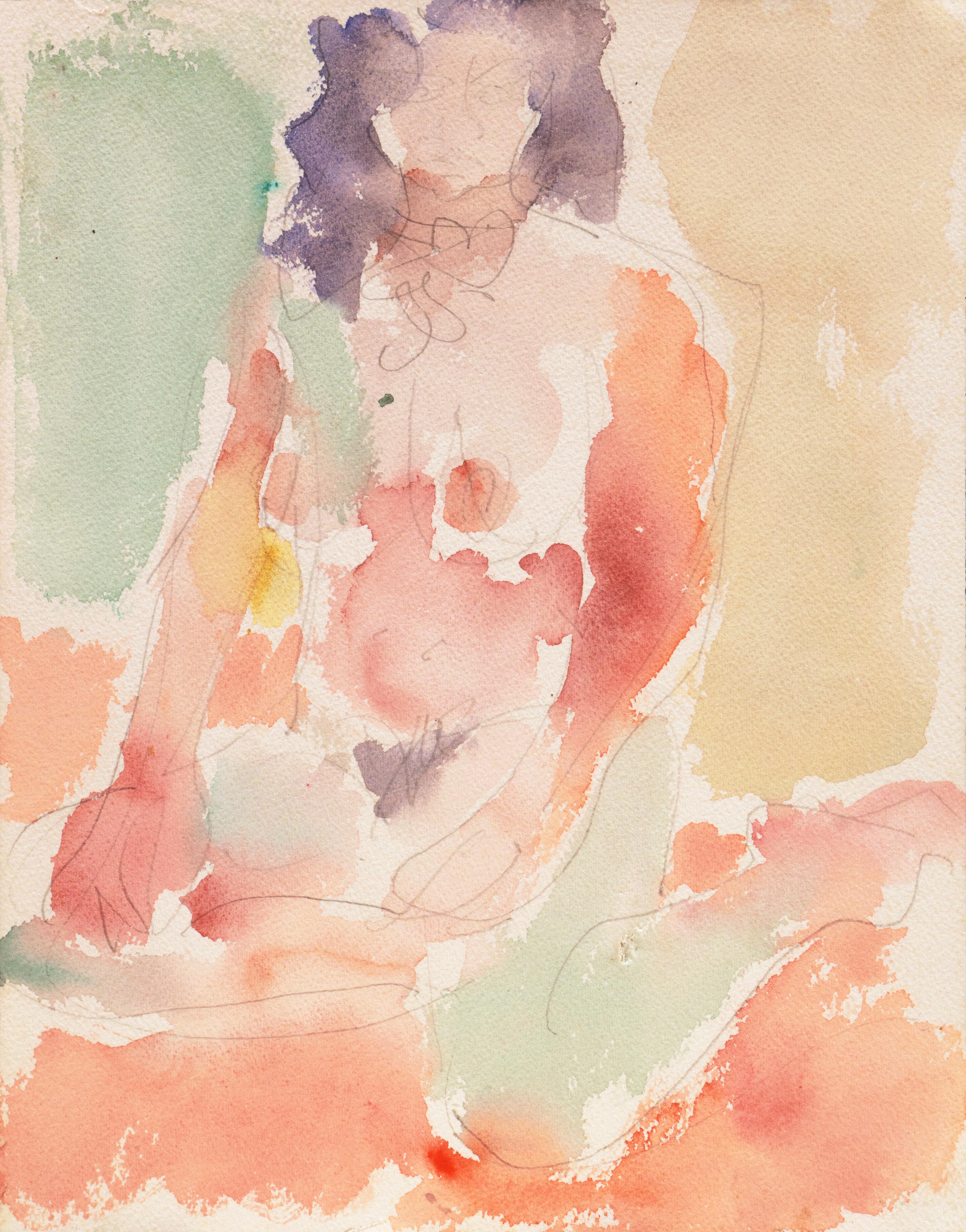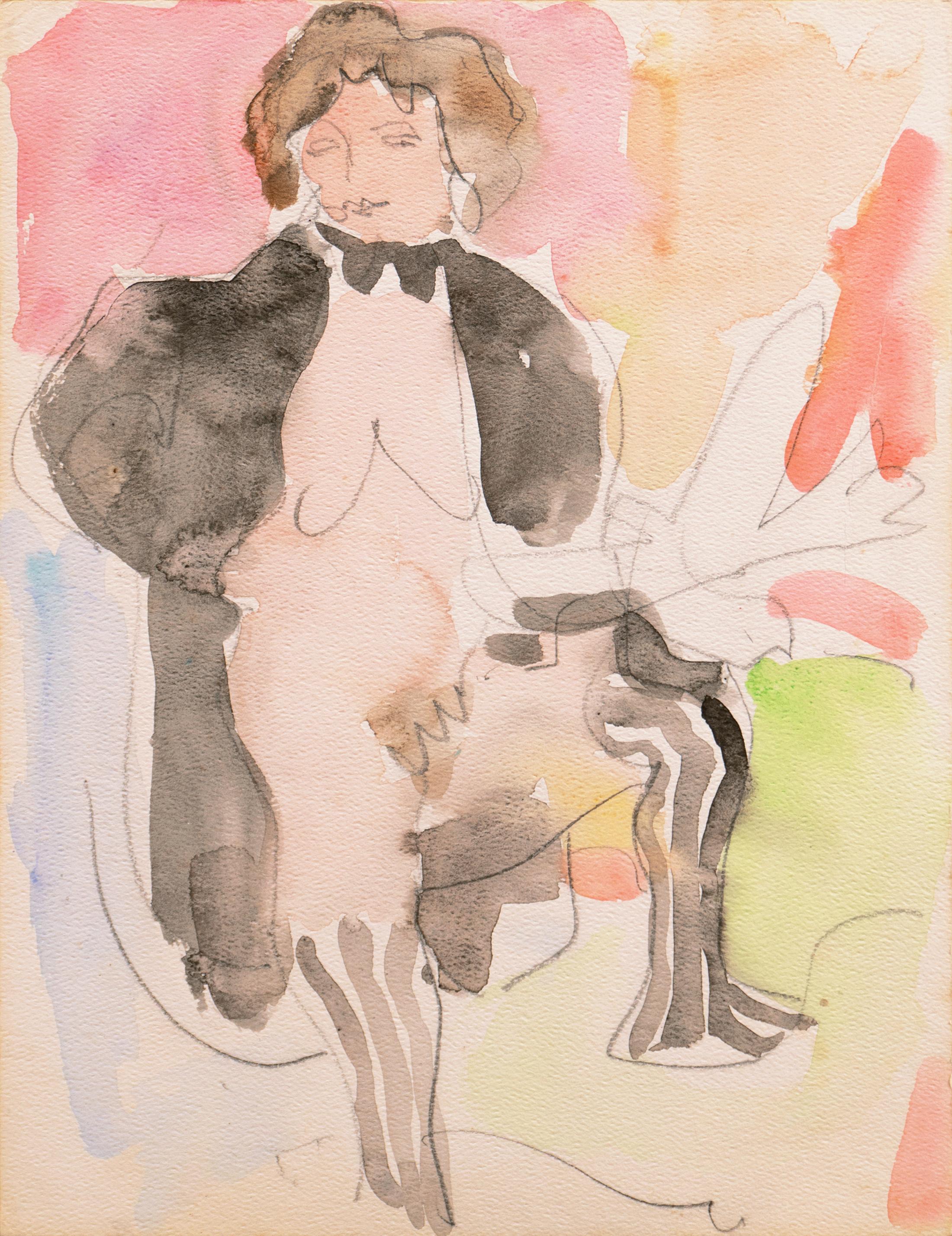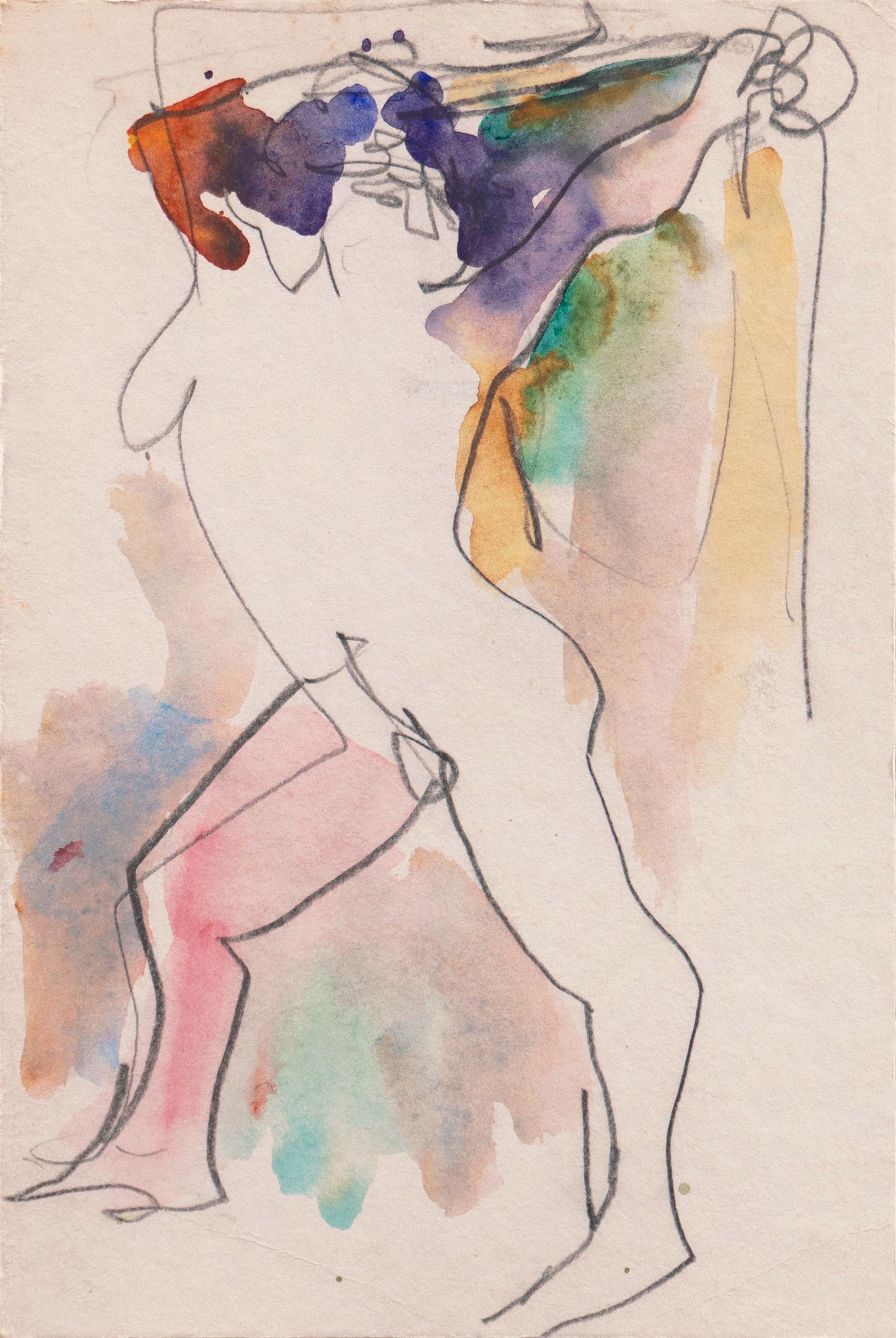Items Similar to Watercolor Painting Three Black Men
Want more images or videos?
Request additional images or videos from the seller
1 of 7
Irene Hodes NewmanWatercolor Painting Three Black Men
About the Item
This does not appear to be signed but was framed with her biography verso.
Irene Hodes Newman, an Impressionist painter, was known for her watercolors of black people, African American Gullah and Creole people and their culture in New Orleans. born in Cameron, Missouri. Newman was well known for her images of birds, atmospheric scenes of the Georgia Atlantic coast, and cityscapes from Savannah to New York City. A member of the Baltimore Water Color Club, the American Artists Professional League, the National Arts Club in New York City and the Audubon Artists Society. Active from the late 1930s until the mid-1950s, her work hung in exhibitions at the Corcoran Gallery of Art in Washington, D.C. (1939); The American Water Color Society, New York (1939, 1941, 1942); the Morton Gallery, New York (1939, 1940); the Allied Artists of America, New York (1939-1942); the Baltimore Museum of Art, Maryland (1939, 1940, 1948-52); the Art Institute of Chicago (1940, 1941, 1949); the Kansas City Art Institute, Missouri (1940); the Brooklyn Museum (1941); the San Diego Fine Arts Society, California (1941); the Metropolitan Museum of Art, New York (1942); the Springfield Museum of Art, Massachusetts (1945); the Toledo Museum of Art, Ohio (1950); the Pennsylvania Academy of Fine Arts, Philadelphia (1950); and the National Gallery of Art, Washington (1955).
From 1948 until 1955, Newman showed at the Milch Gallery in New York City. In 1949 she was featured there in a show called "Six Watercolorists." During this period she was based in New York City, showing paintings of birds as well as New York views. Newman also showed at the Grand Central Art Gallery in New York City in 1955.
- Creator:
- Dimensions:Height: 14 in (35.56 cm)Width: 20 in (50.8 cm)
- Medium:
- Movement & Style:
- Period:
- Condition:minor toning.
- Gallery Location:Surfside, FL
- Reference Number:1stDibs: LU38212660512
About the Seller
4.9
Platinum Seller
These expertly vetted sellers are 1stDibs' most experienced sellers and are rated highest by our customers.
Established in 1995
1stDibs seller since 2014
1,560 sales on 1stDibs
Typical response time: 1 hour
- ShippingRetrieving quote...Ships From: Surfside, FL
- Return PolicyA return for this item may be initiated within 3 days of delivery.
More From This SellerView All
- Surrealist fantasy Watercolor Painting Viennese ExpressionistBy Heimrad PremLocated in Surfside, FLHeimrad Prem (1934 – 1978) was a German painter born in Roding, Oberpfalz. From 1949–1952 he studied decorative painting at Schwandorf and then studied painting with Josef Oberberger...Category
1970s Fauvist Figurative Drawings and Watercolors
MaterialsWatercolor
- Rare Oil Painting Arab Man Bezalel School Jerusalem 1913, JudaicaBy Isaac Lichtenstein 1Located in Surfside, FLExtremely rare work of art from the early Bezalel School of Boris Schatz in Ottoman Palestine. it depicts an Orientalist Arab Sheik in traditional Headwear. YITSKHOK LIKHTENSHTEYN ...Category
Early 20th Century Post-Impressionist Figurative Paintings
MaterialsPaper, Oil Pastel, Oil
- Men Working on Kibbutz Palestine, Israeli Judaica Pastel DrawingBy Eliyahu SigardLocated in Surfside, FLFrom The British mandate Pre State of Israel Palestine Period. Eliahu Sigad (Eliyahu Sigard), painter, born 1901, Lithuania. Founder of Israeli Painters' Association. Educated in Eur...Category
1940s Fauvist Figurative Drawings and Watercolors
MaterialsPaper, Oil Crayon, Pastel
- Vintage Israel Bezalel School Watercolor Painting Artist with Model Kibbutz LifeBy Moshe AvniLocated in Surfside, FLMoshe Avni was born in 1937, in Kibbutz Kfar Blum in the Upper Galilee in Israel. Presently, he lives and paints in Jerusalem. During the years 1956-1957, he studied Painting and Gra...Category
1960s Modern Figurative Drawings and Watercolors
MaterialsWatercolor, Pen
- Chaim Gross Mid Century Mod Judaica Jewish Watercolor Painting Rabbis WPA ArtistBy Chaim GrossLocated in Surfside, FLChaim Gross (American, 1904-1991) Watercolor painting Rabbinical Talmudic Discussion Hand signed 17 x 29 framed, paper 10 x 22 Chaim Gross (March 17, 1904 – May 5, 1991) was an American modernist sculptor and educator. Gross was born to a Jewish family in Austrian Galicia, in the village of Wolowa (now known as Mezhgorye, Ukraine), in the Carpathian Mountains. In 1911, his family moved to Kolomyia (which was annexed into the Ukrainian USSR in 1939 and became part of newly independent Ukraine in 1991). When World War I ended, Gross and brother Avrom-Leib went to Budapest to join their older siblings Sarah and Pinkas. Gross applied to and was accepted by the art academy in Budapest and studied under the painter Béla Uitz, though within a year a new regime under Miklos Horthy took over and attempted to expel all Jews and foreigners from the country. After being deported from Hungary, Gross began art studies at the Kunstgewerbeschule in Vienna, Austria shortly before immigrating to the United States in 1921. Gross's studies continued in the United States at the Beaux-Arts Institute of Design, where he studied with Elie Nadelman and others, and at the Art Students League of New York, with Robert Laurent. He also attended the Educational Alliance Art School, studying under Abbo Ostrowsky, at the same time as Moses Soyer and Peter Blume. In 1926 Gross began teaching at The Educational Alliance, and continued teaching there for the next 50 years. Louise Nevelson was among his students at the Alliance (in 1934), during the time she was transitioning from painting to sculpture. In the late 1920s and early 1930s he exhibited at the Salons of America exhibitions at the Anderson Galleries and, beginning in 1928, at the Whitney Studio Club. In 1929, Gross experimented with printmaking, and created an important group of 15 linocuts and lithographs of landscapes, New York City streets and parks, women in interiors, the circus, and vaudeville. The entire suite is now in the collection of the Philadelphia Museum of Art. Gross returned to the medium of printmaking in the 1960s, and produced approximately 200 works in the medium over the next two decades. For more than sixty years Chaim Gross's art has expressed optimistic, affirming themes, Judaica, balancing acrobats, cyclists, trapeze artists and mothers and children convey joyfulness, modernism, exuberance, love, and intimacy. This aspect of his work remained consistent with his Jewish Hasidic heritage, which teaches that only in his childlike happiness is man nearest to God. In March 1932 Gross had his first solo exhibition at Gallery 144 in New York City. For a short time they represented Gross, as well as his friends Milton Avery, Moses Soyer, Ahron Ben-Shmuel and others. Gross was primarily a practitioner of the direct carving method, with the majority of his work being carved from wood. Other direct carvers in early 20th-century American art include William Zorach, Jose de Creeft, and Robert Laurent. Works by Chaim Gross can be found in major museums and private collections throughout the United States, with substantial holdings (27 sculptures) at the Hirshhorn Museum and Sculpture Garden. A key work from this era, now at the Smithsonian American Art Museum, is the 1932 birds-eye maple Acrobatic Performers, which is also only one and one quarter inch thick. In 1933 Gross joined the government's PWAP (Public Works of Art Project), which transitioned into the WPA (Works Progress Administration), which Gross worked for later in the 1930s. Under these programs Gross taught and demonstrated art, made sculptures that were placed in schools and public colleges, made work for Federal buildings including the Federal Trade Commission Building, and for the France Overseas and Finnish Buildings at the 1939 New York World's Fair. Gross was also recognized during these years with a silver medal at the Exposition universelle de 1937 in Paris, and in 1942, with a purchase prize at the Metropolitan Museum of Art's "Artists for Victory" exhibition for his wood sculpture of famed circus performer Lillian Leitzel. In 1949 Gross sketched Chaim Weizmann, Israeli President, at several functions in New York City where Weizmann was speaking, Gross completed the bust in bronze later that year. Gross returned to Israel for three months in 1951 (the second of many trips there in the postwar years) to paint a series of 40 watercolors of life in various cities. This series was exhibited at the Jewish Museum (Manhattan) in 1953. He also did some important Hebrew medals. In the 1950s Gross began to make more bronze sculptures alongside his wood and stone pieces, and in 1957 and 1959 he traveled to Rome to work with famed bronze foundries including the Nicci foundry. At the end of the decade Gross was working primarily in bronze which allowed him to create open forms, large-scale works and of course, multiple casts. Gross's large-scale bronze The Family, donated to New York City in 1991 in honor of Mayor Ed Koch, and installed at the Bleecker Street Park at 11th street, is now a fixture of Greenwich Village. In 1959, a survey of Gross's sculpture in wood, stone, and bronze was featured in the exhibit Four American Expressionists curated by Lloyd Goodrich at the Whitney Museum of American Art, with work by Abraham Rattner, Doris Caesar, and Karl Knaths. In 1976, a selection from Gross's important collection of historic African sculpture, formed since the late 1930s, was exhibited at the Worcester Art Museum in the show The Sculptor's Eye: The African Art Collection of Mr. and Mrs. Chaim Gross. Gross was elected into the National Academy of Design as an Associate member, and became a full Academician in 1981. In 1984, he was inducted into the American Academy of Arts and Letters, with Jacob Lawrence and Lukas Foss. In the fall of 1991, Allen Ginsberg gave an important tribute to Gross at the American Academy of Arts and Letters, which is published in their Proceedings. In 1994, Forum Gallery, which now represents the Chaim Gross estate, held a memorial exhibition featuring a sixty-year survey of Gross's work.In March 1932 Gross had his first solo exhibition at Gallery 144 in New York City. For a short time they represented Gross, as well as his friends Milton Avery, Moses Soyer, Ahron Ben-Shmuel and others. Gross was primarily a practitioner of the direct carving method, with the majority of his work being carved from wood. Other direct carvers in early 20th-century American art include William Zorach, Jose de Creeft, and Robert Laurent. Works by Chaim Gross can be found in major museums and private collections throughout the United States, with substantial holdings (27 sculptures) at the Hirshhorn Museum and Sculpture Garden. A key work from this era, now at the Smithsonian American Art Museum, is the 1932 birds-eye maple Acrobatic Performers, which is also only one and one quarter inch thick. In 1933 Gross joined the government's PWAP (Public Works of Art Project), which transitioned into the WPA (Works Progress Administration), which Gross worked for later in the 1930s. Under these programs Gross taught and demonstrated art, made sculptures that were placed in schools and public colleges, made work for Federal buildings including the Federal Trade Commission Building, and for the France Overseas and Finnish Buildings at the 1939 New York World's Fair. Gross was also recognized during these years with a silver medal at the Exposition universelle de 1937 in Paris, and in 1942, with a purchase prize at the Metropolitan Museum of Art's "Artists for Victory" exhibition for his wood sculpture of famed circus performer Lillian Leitzel. In 1949 Gross sketched Chaim Weizmann, President of Israel, at several functions in New York City where Weizmann was speaking, Gross completed the bust in bronze later that year. Gross returned to Israel for three months in 1951 (the second of many trips there in the postwar years) to paint a series of 40 watercolors of life in various cities. This series was exhibited at the Jewish Museum (Manhattan) in 1953. In the 1950s Gross began to make more bronze sculptures alongside his wood and stone pieces, and in 1957 and 1959 he traveled to Rome to work with famed bronze foundries including the Nicci foundry. At the end of the decade Gross was working primarily in bronze which allowed him to create open forms, large-scale works and of course, multiple casts. Gross's large-scale bronze The Family, donated to New York City in 1991 in honor of Mayor Ed Koch, and installed at the Bleecker Street Park at 11th street, is now a fixture of Greenwich Village. In 1959, a survey of Gross's sculpture in wood, stone, and bronze was featured in the exhibit Four American Expressionists curated by Lloyd Goodrich at the Whitney Museum of American Art, with work by Abraham Rattner, Doris Caesar, and Karl Knaths. In 1976, a selection from Gross's important collection of historic African sculpture, formed since the late 1930s, was exhibited at the Worcester Art Museum in the show The Sculptor's Eye: The African Art Collection of Mr. and Mrs. Chaim Gross. Gross was elected into the National Academy of Design as an Associate member, and became a full Academician in 1981. In 1984, he was inducted into the American Academy of Arts and Letters, with Jacob Lawrence and Lukas Foss. In the fall of 1991, Allen Ginsberg gave an important tribute to Gross at the American Academy of Arts and Letters, which is published in their Proceedings. In 1994, Forum Gallery, which now represents the Chaim Gross estate, held a memorial exhibition featuring a sixty-year survey of Gross's work. Gross was a professor of printmaking and sculpture at both the Educational Alliance and the New School for Social Research in New York City, as well as at the Brooklyn Museum Art School, the MoMA art school, the Art Student's League and the New Art School (which Gross ran briefly with Alexander Dobkin...Category
Mid-20th Century American Modern Figurative Drawings and Watercolors
MaterialsPaper, Watercolor
- Jerusalem Old City Landscape, Expressionist Judaica Israeli Painting IIBy Andre ElbazLocated in Surfside, FLIn this painting the artist uses gestural brushstrokes, which causes distortion and exaggeration for emotional effect. Andre Elbaz uses as his subject figures walking in old city Jerusalem. André Elbaz (born April 26, 1934, El Jadida, Morocco) is a famous Moroccan painter and filmmaker. Elbaz studied art and theatre in Rabat and Paris from 1950 to 1961. He started painting only at the age of 21, until which age he had been interested mainly in theatre. A few years later, he managed to combine his two passions into a new approach in art-therapy, inventing together with his wife, a psychiatrist, the Pictodrame, which brought him world recognition. His first exhibition, which was very successful, took place in Casablanca in 1961 and earned him an appointment as Professor at the Beaux-Arts school in Casablanca. Years later, in 1976, he exhibited his paintings at the Tel-Aviv Museum. In parallel to his career as a painter, Elbaz is also known as a filmmaker. He produced several short films in France, Canada and the United States. One of them, La nuit n'est jamais complète (The night is never complete), won a prize at the "5th Biennale de Paris in 1967". Among the themes chosen for the many films he produced, there was a short one about the Warsaw Ghetto uprising, as well as a series of drawings entitled Seuls (Alone), with texts written by both Elie Wiesel...Category
20th Century Expressionist Figurative Paintings
MaterialsGouache, Paper
You May Also Like
- Woman carrying a burdenLocated in PARIS, FRBeau dessin au lavis d'encre avec réhauts d'aquarelle d'un peintre français du XIXe. L'œuvre est signée en bas à gauche : à déchiffrer. Daté de juillet 1852. Dimensions : 24 x 15.5 cmCategory
Late 19th Century Post-Impressionist Figurative Drawings and Watercolors
MaterialsWatercolor
- 'Seated Nude', Musee d'Art Moderne, Paris, SFAA, LACMA, California Woman ArtistBy Janet Ament De La RocheLocated in Santa Cruz, CASigned lower right, 'Ament' for Janet Ament De La Roche (American, 1916-2000) and titled, 'Helene'; additionally bearing artist's estate stamp verso. Winner of the Prix Othon Friesz...Category
1950s Post-Impressionist Figurative Drawings and Watercolors
MaterialsPaper, Watercolor
- 'Seated Nude' Paris, Louvre, Salon d'Automne, Académie Chaumière, LACMA, SFAABy Victor Di GesuLocated in Santa Cruz, CAPainted circa 1955 by Victor Di Gesu, (American, 1914-1988). Stamped verso with certification of authenticity. Winner of the Prix Othon Friesz, Victor di Gesu first attended the Lo...Category
1950s Post-Impressionist Figurative Drawings and Watercolors
MaterialsPaper, Watercolor
- 'Seated Nude', Paris, Louvre, Académie Chaumière, Salon D'Automne, LACMA, SFAABy Victor Di GesuLocated in Santa Cruz, CAStamped, verso, with estate stamp for Victor Di Gesu (American, 1914-1988) and created circa 1950. Winner of the Prix Othon Friesz, Victor di Gesu first attended the Los Angeles Art...Category
1950s Post-Impressionist Figurative Drawings and Watercolors
MaterialsGouache, Watercolor, Paper
- 'Black Tie and Tail', Paris, Louvre, Académie Chaumière, LACMA, SFAA, CarmelBy Victor Di GesuLocated in Santa Cruz, CAStamped verso for estate of Victor Di Gesu (American, 1914-1988) and painted circa 1955. A Post-Impressionist figural watercolor showing a young woman partially-clothed in evening w...Category
1950s Post-Impressionist Nude Drawings and Watercolors
MaterialsWatercolor, Paper, Graphite
- 'Standing Nude', Paris, Louvre, Académie Chaumière et Etrangères, LACMA, SFAABy Victor Di GesuLocated in Santa Cruz, CAStamped, verso, with estate stamp for Victor Di Gesu (American, 1914-1988) and created circa 1950. A bold figural study of a nude in contrapposto, shown posing with drapery and cont...Category
1950s Post-Impressionist Figurative Drawings and Watercolors
MaterialsPaper, Gouache, Graphite





